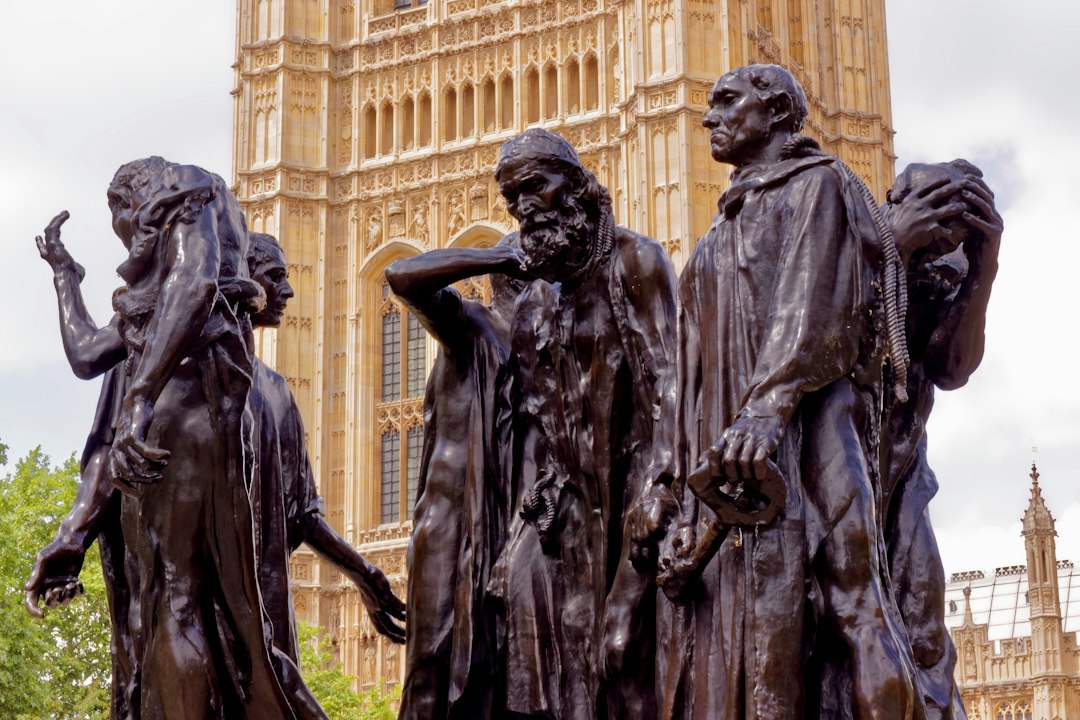The Tower of London is one of the most iconic landmarks in England, known for its rich history and dark reputation. Located on the banks of the River Thames, this imposing fortress has stood for over 900 years, witnessing centuries of political intrigue, royal power struggles, and gruesome executions. Today, it stands as a popular tourist destination and a UNESCO World Heritage Site, attracting millions of visitors each year who come to explore its haunting past.
Key Takeaways
- The Tower of London is a haunting fortress with a dark past and secrets.
- The Tower has a long history, from a Roman settlement to a royal palace.
- The Tower played a significant role in medieval England as a place of power and punishment.
- The Tower housed notorious prisoners, including Anne Boleyn and Guy Fawkes.
- The Tower’s bloody past includes torture, execution, and the infamous Traitor’s Gate.
The Tower’s Early History: From Roman Settlement to Royal Palace
The origins of the Tower of London can be traced back to Roman times when it was initially built as a fortification to protect the city of Londinium. The Romans established a settlement on the site in the 1st century AD, and remnants of their defensive walls can still be seen today. Over the centuries, the fortification evolved into a royal palace, serving as a residence for English monarchs.
In the 11th century, William the Conqueror ordered the construction of a stone keep within the walls of the Tower, known as the White Tower. This impressive structure became the centerpiece of the fortress and set the stage for its future as a symbol of royal power.
The Tower’s Role in Medieval England: A Place of Power and Punishment
During the medieval period, the Tower of London played a crucial role in English politics and governance. It served as a symbol of royal authority and was often used as a prison for political dissidents and enemies of the crown. The Tower’s reputation as a place of punishment and torture grew during this time, with many prisoners enduring horrific conditions within its walls.
One of the most famous prisoners held at the Tower was Anne Boleyn, the second wife of King Henry
Accused of adultery and treason, she was imprisoned in the Tower before being executed by beheading in 1536. Other notable prisoners included Sir Walter Raleigh, who spent over a decade in the Tower before being executed, and Guy Fawkes, who was held there after his failed attempt to blow up the Houses of Parliament in 1605.
The Tower of London’s Notorious Prisoners: From Anne Boleyn to Guy Fawkes
The Tower of London has housed many infamous prisoners throughout its history. One of the most well-known is Anne Boleyn, the second wife of King Henry
Accused of adultery and treason, she was imprisoned in the Tower before being executed by beheading in 1536. Her imprisonment and subsequent execution are often seen as a symbol of the power struggles and political intrigue of the Tudor era.

Another notable prisoner held at the Tower was Sir Walter Raleigh, an English explorer and writer. He was imprisoned for over a decade on charges of treason before being executed in 1618. Raleigh’s time in the Tower is often romanticized in literature and has become part of his enduring legacy.
Perhaps one of the most infamous prisoners held at the Tower was Guy Fawkes, who was involved in the Gunpowder Plot of 1605. Fawkes and his co-conspirators planned to blow up the Houses of Parliament, but their plot was foiled. Fawkes was captured and held at the Tower before being executed for treason. Today, his effigy is burned on Bonfire Night, commemorating the failed plot.
The Tower’s Bloody Past: Torture, Execution, and the Traitor’s Gate
The Tower of London has a dark history as a site of torture and execution. Many prisoners were subjected to brutal interrogation methods within its walls, including the infamous rack and thumbscrew. These instruments were used to extract confessions from prisoners, often resulting in false admissions.
Executions at the Tower were carried out in a variety of ways, including beheading, hanging, and drawing and quartering. The most famous execution at the Tower was that of Anne Boleyn, who was beheaded on the orders of her husband, King Henry
Her execution took place on Tower Green, a grassy area within the Tower’s walls.
The Traitor’s Gate is another chilling feature of the Tower’s bloody past. This entrance was used to bring prisoners into the Tower by boat, often after they had been arrested elsewhere. Notable prisoners who entered the Tower through the Traitor’s Gate include Sir Thomas More and Queen Elizabeth I before she became queen.
The Crown Jewels: An Iconic Treasure Housed in the Tower’s Jewel House
One of the most popular attractions at the Tower of London is the Jewel House, where the Crown Jewels are kept. These priceless treasures include crowns, scepters, orbs, and other regalia used in coronations and other royal ceremonies. The Crown Jewels have a long and fascinating history, with some pieces dating back to the 12th century.
The Crown Jewels are closely guarded and protected within the Tower’s walls. Visitors can view them in a specially designed vault, where they are displayed in all their splendor. The collection includes the Imperial State Crown, which is worn by the monarch during the State Opening of Parliament, as well as the Sovereign’s Scepter with Cross, which contains the world’s largest cut diamond.
The Tower’s Ghosts and Legends: From the White Lady to the Headless Haunts
The Tower of London is renowned for its ghost stories and legends. Over the centuries, numerous sightings of ghosts and paranormal phenomena have been reported within its walls. One of the most famous ghosts is that of Anne Boleyn, who is said to haunt the Tower Green where she was executed. Visitors have reported seeing her ghostly figure walking the grounds, often carrying her severed head.
Another well-known ghost is the White Lady, believed to be the spirit of Arbella Stuart, a cousin of King James
Arbella was imprisoned in the Tower and died there under mysterious circumstances. Her ghost is said to appear in a white dress, wandering the halls of the Tower.
Other ghostly apparitions include the headless haunts, believed to be the spirits of those who were executed at the Tower. These ghostly figures are often seen walking the corridors, carrying their severed heads or searching for their lost body parts.
The Tower’s Military History: A Fortress and Armory for England’s Defense
In addition to its role as a royal residence and prison, the Tower of London has a long history as a fortress and armory. It served as a stronghold for the defense of London and played a crucial role in many military conflicts throughout history.
During World War II, the Tower was used as a secure location for storing valuable artifacts and documents. The Crown Jewels were moved to a secret location for safekeeping, and the Tower’s walls were reinforced to protect against bombing raids. Today, visitors can explore the Tower’s military history through its exhibits and displays, which showcase weapons, armor, and other artifacts from various periods.
The Tower Today: A Popular Tourist Destination and World Heritage Site
Today, the Tower of London is one of the most popular tourist attractions in England. It welcomes millions of visitors each year who come to explore its rich history and experience its haunting atmosphere. The Tower offers guided tours led by Yeoman Warders, also known as Beefeaters, who provide insights into its past and share fascinating stories about its famous prisoners and ghostly inhabitants.
In 1988, the Tower of London was designated as a UNESCO World Heritage Site in recognition of its historical significance and architectural importance. The site is carefully preserved and maintained, allowing visitors to step back in time and immerse themselves in the Tower’s dark and intriguing past.
Exploring the Tower of London’s Dark History and Legacy
The Tower of London is a fortress with a complex and fascinating history. From its origins as a Roman fortification to its role as a royal residence, prison, and armory, the Tower has witnessed centuries of political intrigue, power struggles, and gruesome executions. Today, it stands as a popular tourist destination and a UNESCO World Heritage Site, offering visitors the chance to explore its haunting past and learn about the dark secrets that lie within its walls. Whether you’re interested in history, architecture, or ghost stories, a visit to the Tower of London is sure to leave a lasting impression.
FAQs
What is the Tower of London?
The Tower of London is a historic castle located in central London, England. It was built in the 11th century by William the Conqueror and has served as a royal palace, prison, and fortress throughout its history.
What is the purpose of the Tower of London?
The Tower of London has served many purposes throughout its history, including as a royal residence, a prison, a treasury, and a place to store the Crown Jewels. Today, it is a popular tourist attraction and a UNESCO World Heritage Site.
What are some of the famous attractions at the Tower of London?
Some of the famous attractions at the Tower of London include the Crown Jewels, the White Tower, the Tower Green, and the Ravens. Visitors can also see the medieval architecture and learn about the history of the Tower through guided tours and exhibits.
What is the history of the Tower of London?
The Tower of London was built in 1066 by William the Conqueror as a symbol of Norman power. Throughout its history, it has been used as a royal palace, a prison, and a fortress. It has also been the site of many important events in English history, including the execution of Anne Boleyn and the imprisonment of Sir Walter Raleigh.
Is the Tower of London haunted?
Many people believe that the Tower of London is haunted by the ghosts of former prisoners and executed individuals. Some of the most famous ghost stories include the ghost of Anne Boleyn, who is said to haunt the Tower Green, and the ghost of Sir Walter Raleigh, who is said to haunt the Bloody Tower.
Can visitors go inside the Tower of London?
Yes, visitors can go inside the Tower of London and explore the various attractions and exhibits. However, some areas of the Tower may be closed off to the public for maintenance or restoration work.
How much does it cost to visit the Tower of London?
The cost of admission to the Tower of London varies depending on the type of ticket and the age of the visitor. As of 2021, adult tickets start at £25.00 and child tickets start at £12.00. Discounts are available for seniors, students, and families.







